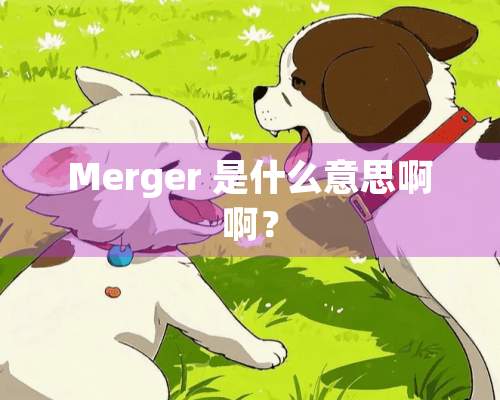Merger 是什么意思啊啊?
- 百科常识
- 万才仞
- 2023-10-25 08:22:10
- 2
今天宠物迷的小编给各位宠物饲养爱好者分享merger什么牌子的宠物知识,其中也会对Merger 是什么意思啊啊?(Merge是什么意思)进行专业的解释,如果能碰巧解决你现在面临的宠物相关问题,别忘了关注本站哦,现在我们开始吧!
Merger 是什么意思啊啊?
同学你好,很高兴为您解答! Merger的翻译是合并,您所说的这个词语,是属于CMA核心词汇的一个,掌握好CMA词汇可以让您在CMA的学习中如鱼得水,这个词的意义如下:两家或以上公司结合,一般做法为向一家公司的股东提供收购方的股份,换取他们让出被收购公司的股份。 希望高顿网校的回答能帮助您解决问题,更多财会问题欢迎提交给高顿企业知道。 高顿祝您生活愉快!

vertical merger是什么意思
vertical merger
[英][ˈvə:tikəl ˈmɜ:dʒə][美][ˈvɚtɪkəl ˈmədʒɚ]
垂直合并; 纵向合并,垂直兼并;
例句:
1.
Vertical merger a merger between two companies producing different goods orservices for one specific finished product.
纵向合并指为同一种制成品生产不同货品及服务的两家公司的合并。
2.
With a vertical merger strategy, you may acquire one of your suppliers and becomeyour own supplier.
纵向兼并策略可以使得企业收购其中一个供应商而自己变成了自己的供应商。
机顶盒里的 merger是什么意思
merger ['mə:dʒə] n. (企业等的)合并;并购;吸收(如刑法中重罪吸收轻罪)
merger: 合并;并购;归并;并吞 合并
Encourage merger: 鼓励兼并
merger agreement: 合并协议
哪位有关于欧洲历史的英语文章(1百字到1千字都行)
Greco-Roman civilizations dominated Classical antiquity starting in Ancient Greece, generally considered to be the seminal culture which provided the foundation of Western civilisation and influential on language, politics, educational systems, philosophy, science and the arts, with the writing of the epic Iliad at around 700 BC. Those values were acquired by the Roman Republic established in 509 BC, having expanded from Italy, centred in the Mediterranean Sea, until the Roman Empire reached its greatest extent around the year 150.
After a period of civil wars, emperor Constantine I shifted the capital from Rome to the Greek town Byzantium in 313, then renamed Constantinople (modern Istanbul), having legalised Christianity. In 395 the empire was permanently split in two, with the Western Roman Empire repeatedly attacked during the migration period. Rome was sacked in 410 by the Visigoths, the first of the Germanic peoples migrating into Roman territories. With the last West Roman emperor removed in 476, Southeastern Europe and some parts of the Mediterranean remained under the Eastern Roman Empire (Byzantine Empire) up to the later 6th century.
As Constantinople faltered, Germanic peoples established kingdoms in western territories. The new states shared Latin written language, lingering Roman culture and Christian religion. Much territory was brought under the rule of the Franks by Charlemagne, whom the pope crowned western Emperor in 800, but soon divided while Europe came under attack from Vikings, Muslims from North Africa, and Magyars from Hungary. By the mid-10th century the threat had decreased, although Vikings remained threatening Britain and Ireland.
After the establishment of Constantinople and the creation of a church there, which replaced the pre-existing bishopric of Heracleia nearby, tensions between the new and rapidly growing church and the church of Rome gradually increased, with doctrinal disputes masking the struggle for primacy. One well known instance of such tension (although it did not lead to a formal schism) occurred when in 1054 AD a legate of the pope, Cardinal Humbert, formally excommunicated the patriarch of Constantinople, an excommunication which was repeated against him the following day. However, from 1095 a series of religiously sanctioned military campaigns began to be waged by coalitions of Latin Christian Europeans, in response to a call from the Byzantine Empire, for help against the Muslim expansion. Spain, southern France, Lithuania and pagan regions were consolidated during this time, with the last large-scale crusade of the Middle Ages fought in 1396. Complex feudal loyalties developed and the aristocracy of new nations become very closely related by intermarriage. The feudal society began to break as Mongol invaded frontier areas and the Black Death pandemic killed from 30% to 60% of Europe's population.[1]
Beginning roughly in the 14th century in Florence, and later spreading through Europe with the development of printing press, a Renaissance of knowledge challenged traditional doctrines in science and theology, with the rediscovery of classical Greek and Roman knowledge. Simultaneously Protestant Reformation under German Martin Luther questioned Papal authority. Henry VIII sundered the English Church, allying in ensuing religious wars between German and Spanish rulers. The Reconquista of Portugal and Spain led to a series of oceanic explorations resulting in the age of discovery that established direct links with Africa, the Americas and Asia, while religious wars continued to be fought in Europe,[2] which ended in 1648 with the Peace of Westphalia.
European overseas expansion led to the rise of colonial empires, producing the Columbian Exchange.[3] The combination of resource inflows from the New World and the Industrial Revolution of Great Britain, allowed a new economy based on manufacturing instead of subsistence agriculture.[4] Starting in 1775, British Empire colonies in America revolted to establish a representative government. Political change in continental Europe was spurred by the French Revolution under the motto liberté, egalité, fraternité. The ensuing French leader, Napoleon Bonaparte, conquered and enforced reforms through war up to 1815.
The period between 1815 and 1871 saw a large number of revolutionary attempts and independence wars. In France and the United Kingdom, socialist and trade union activity developed. The last vestiges of serfdom were abolished in Russia in 1861[5] and Balkan nations began to regain independence from the Ottoman Empire. After the Franco-Prussian War, Germany and Italy unified into nation states, and most European states had become constitutional monarchies by 1871.
Rivalry in a scramble for empires spread. The outbreak of the First World War was precipitated by a series of struggles among the Great Powers. War and poverty triggered the Russian Revolution which led to the formation of the communist Soviet Union. Hard conditions imposed on Germany by the Treaty of Versailles and the Great Depression led to the rise of fascism in Germany as well as in Italy, Spain and other countries. The rise of the irredentist totalitarian regime Nazi Germany led to a Second World War.
Following the end of the Second World War, Europe was divided by the Iron Curtain between an American dominated west and a Soviet dominated east. Western countries came under US protection via NATO and formed the European Economic Community amongst themselves. The East was dominated by communist countries under the Soviet Union's economic and military leadership. There were also a number of neutral countries in between.
In the late 1980s, the Soviet Union fell and former Communist Bloc countries gained independence. The west's economic integration deepened and the European Union expanded to include most of the former-communist Eastern Europe in 2004.
急求个介绍某一个国际服装品牌的PPT
不适合?刚才那个。。。= =
怎么区分joint operation和joint venture?有什么不同吗
joint
operation
共同作业 [经] 联合操作 [计] 联合经营 [经管] 联合作业 [经] 同时操作
[计]
joint
venture
短期合伙 [经] 共同投资 [经] 合营企业 [经] 合营者 [经管] 合资经营 [经] 合资经营企业
[经] 联合经营 [经管] 联营企业 [经管] 临时合伙 [经管]
请教 acquisition, takeover,merger的区别
merger, consolidation, acquisition, takeover
关于收购兼并,英语里有几个词都表达这一概念,但意义略有不同。
merger 和 consolidation 都指“合并”,但merger(兼并)指的是出价公司A收购目标公司B,合并成一个公司A,也称“吸收合并”;consolidation 指两公司A、B合并创立新公司C,也称“创立合并”。 acquisition(购并),指一家公司全部或部分买下另一家公司,取得所有权;takeover(接管,收购),包括三种形式:acquisition(购并)、proxy contest(收购委托书)和 going private(私有化)。
德国唯宝值得信赖吗?
还不错的一个牌子!
德国唯宝卫浴,诞生于1748年,至今已有二百六十多年的历史了,素有被誉为“德国卫浴瑰宝”之称,独具的风格和设计理念让唯宝(Villeroy&Boch)品牌在历史长河中经历近三个世纪之久,成为各国贵族、皇室的首选,在欧洲各国,使用唯宝(Villeroy&Boch)的产品已经成了“尊贵”的另一个代名词。
德国唯宝(Villeroy&Boch)于1748年成立于德国的麦特拉赫镇,近三百年来,唯宝(Villeroy&Boch)凭借其无穷的创意,树立了享誉国际的品牌,更让它在世界各展览与潮流展览中收到无数奖章,它也因此被称为“国际生活风尚专家”。
相比其他品牌,德国唯宝更是一个深入植根于欧洲传统精髓的品牌。
唯宝洁具以设计作为这个品牌的核心精神,对抗大工业批量生产所带来的粗俗简陋。外观以艺术设计见长,打破了传统洁具的设计路数,将革新理念融入浴室等洁具设计世界之中,创造出了全新的洁具文化,这也是唯宝一直屹立于世界**洁具品牌行列的一条重要的原因。
post-merger是什么意思
post-merger
[词典] 合并后;
[例句]And don't forget the career development advantages of showing how you've led dynamic teams through change in a post-merger or integration type of environment.
别忘了,成功显示你有领导多样化团队的能力在将来类似合并或兼并等变革的情况下会为你带来很多的职业发展优势。
本文由宠物迷 百科常识栏目发布,非常欢迎各位朋友分享到个人朋友圈,但转载请说明文章出处“Merger 是什么意思啊啊?”







